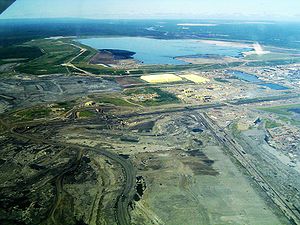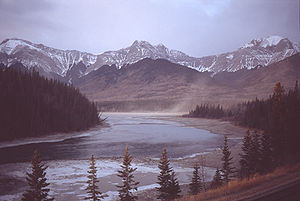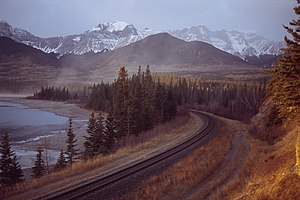 Image via WikipediaENVIRONMENTAL IMPACT OF THE OIL AND GAS INDUSTRY’S CONSUMPTION OF WATER FROM THE ATHABASCA RIVER DURING THE PREDICTED WATER SHORTAGE FOR CANADA’S WESTERN PRAIRIE PROVINCES PDF
Image via WikipediaENVIRONMENTAL IMPACT OF THE OIL AND GAS INDUSTRY’S CONSUMPTION OF WATER FROM THE ATHABASCA RIVER DURING THE PREDICTED WATER SHORTAGE FOR CANADA’S WESTERN PRAIRIE PROVINCES PDFClimate change is predicted to cause decreases in snow pack accumulation and result in continued retreat of
glaciers, both of which will reduce the overall water quantity available downstream.
The oil and gas industry uses large amounts of water in their processes and facilities, some of
which cannot be directly returned to the water cycle. This water is tied up in tailings ponds and
Steam Assisted Gravity Drainage (SAGD) oil reservoirs, but most consumed water is returned to
the water cycle through evaporation.
Watershed Groups Gather to Take Action on Challenges and Opportunities Facing Alberta's Watersheds
 Image via Wikipedia
Image via Wikipedia
Read more: http://www.benzinga.com/pressreleases/10/10/m557183/watershed-groups-gather-to-take-action-on-challenges-and-opportunities-f#ixzz152CQUfA9
 Image via Wikipedia
Image via WikipediaRead more: http://www.benzinga.com/pressreleases/10/10/m557183/watershed-groups-gather-to-take-action-on-challenges-and-opportunities-f#ixzz152CQUfA9
Science Outreach - Athabasca Image via Wikipedia
Image via Wikipedia
Our two main objectives are:
- To promote science awareness in the greater Athabasca area and beyond.
- To document the scientific research done on the Athabasca River Basin.
"Keeping the Athabasca" Citizens' Water Forum and Watershed Stewardship Workshop
A Citizens’ Inquiry into the Monitoring, Management & Protection of our Athabasca Basin Watersheds, Surface & Ground Waters
Safe Drinking Water Foundation
Dr. David Schindler's Interview with CBC News Regarding his Study on Toxins in the Athabasca River
High levels of toxic pollutants in Alberta's Athabasca River system are linked to oilsands mining,
Athabasca River Hydrological Profile
The Athabasca River drains an area of approximately 138,000 km², and flows nearly 1,400 km from its headwaters to the Peace-Athabasca Delta and Lake Athabasca. The Athabasca River system includes a total of 94 rivers, over 150 named creeks, numerous unnamed creeks, and 153 lakes (Science Outreach 2007).
ecopolitology - environmental magazine Image via Wikipedia
Image via Wikipedia
Regional Aquatic monitoring Program
The Regional Aquatics Monitoring Program (RAMP) website provides access to a wide range of information related to the program. RAMP is an industry-funded, multi-stakeholder environmental monitoring program initiated in 1997. The intent of RAMP is to integrate aquatic monitoring activities across different components of the aquatic environment, different geographical locations, and Athabasca oils sands and other developments in the Athabasca oil sands region so that long-term trends, regional issues and potential cumulative effects related to oil sands and other development can be identified and addressed.
The provincial and federal governments have been in dereliction of their duties, to the Albertan people impacted by this development, both from an environmental and a social economic standpoint.
In forty years two acres of Tar Sands mining area has been reclaimed to the levels the Alberta government will certify. For comparison the area of Alberta affected by the Tar Sands, is slightly larger than the country of Greece.
The facts are clear, human health is being compromised, water is being polluted, the environment devastated, the land cannot be restored, and the new Land Use Framework, which is being developed to mitigate the cumulative negative effects of development on the land and thereby the people of Alberta is in direct violation of treaty rights. The federal, provincial, and municipal governments lack the political will to take action on these issues. Thereby the Keepers of the Athabasca resolve to work in coalition with others along the watershed to promote and uphold indigenous rights, promote continued awareness and inspire the public to take action to hold our government responsible."
 Image via Wikipedia
Image via Wikipedia
Interesting Science Links
 Image via Wikipedia
Image via WikipediaInteresting Science Links
Articles, books, science and more. Just dig in, man (or woman) scientist
Appalachia But Not Alberta: Whither the Tar Sands Advocates?
Last week, we wrote about the remarkable paper in Science where a dozen scientists called for a ban on mountaintop removal mining due to the practice's harmful effects on the environment and on human health. There's an even greater environmental crime being perpetrated north of the border, but at least for the moment the semi-equivalent scientists aren't showing quite as much spine.A much less publicized paper and accompanying commentary (PDF, sub's required) were recently released in the Proceedings of the National Academy of Sciences on the high concentrations of various toxic chemical compounds found in the Athabasca River in Alberta as a result of enormous tar sands mining operations. Let's focus on the commentary, as there isn't much point in writing a commentary on someone else's research unless you have something to say. Right? Well, these particular scientists, while clearly aware of the damage being done to the region as dirty bitumen is pulled from the ground, don't call for a ban on anything:
"Currently, the majority of bitumen is recovered by surface-mining practices that require the clearing of large areas of land, resulting in loss of habitat, including migration corridors and breeding grounds for terrestrial and aquatic species. Methods for mitigating and remediating these effects are under development, but even when remediated the habitat will be considerably different from its previous state. These externalities are costs that should be considered when developing this resource."
Pragmatic Advocacy, or Something
The three authors of the commentary go on to discuss the billion-plus cubic feet of "oil sands process water" (read: really dirty liquid that you wouldn't want to stand near let alone drink) in the tailings ponds in the Athabasca region, and the extremely high concentrations of damaging things like polycyclic aromatic hydrocarbons that appear to be finding their way into the ecosystem. The authors conclude:"Global demand for oil and the resulting economic potential mean that development of oil sands will continue. This development has the potential to impact society and the environment significantly. It is essential that any detrimental effects be mitigated as much as possible and that development proceed in a manner that minimizes effects on the health and welfare of the environment, wildlife, and humans like."
One could see this as pragmatic, I suppose. Yes, tar sands development—right, sorry—OIL sands development is certainly likely to continue in the foreseeable future. But I'm not sure why one can't be pragmatic and idealistic at the same time.In the Science paper, the authors asserted that "Regulators should no longer ignore rigorous science." Also, “Mining permits are being issued despite the preponderance of scientific evidence that impacts are pervasive and irreversible and that mitigation cannot compensate for losses." The contrast between the two is striking.
Mountaintop removal ‘clarity’: OK, so now what?
more clarity
EPA is willing to allow one mine to bury multiple miles of streams with waste rock and dirt.
Two things remain important to remember.First, Central Appalachian coal production is headed toward a major, major decline — with or without additional restrictions on mountaintop removal (or greenhouse gases rules for that matter). So whatever surface mining’s economic benefits to the region, policymakers need to get ready for those benefits to begin to evaporate.
Second, the industry just can’t argue with a straight face that mountaintop removal isn’t having negative impacts on the environment in Appalachia. The science that says otherwise is too overwhelming to ignore. Undoubtedly, the two new EPA studies released yesterday (see here and here) will only add to that science.
( Like Appalachia, Alberta will end up 'holding the bag' )
Healing Walk Past Toxic Tailings Ponds
But What Is To Be Done? (a recurring theme)
Worth a read in its entirety is this practical, well-informed piece by Maude Barlow.
For too long environmentalists have toiled in isolation from those communities and groups working for human and social justice and for fundamental change to the system. On one hand are the scientists, scholars, and environmentalists warning of a looming ecological crisis and monitoring the decline of the world’s freshwater stocks, energy sources and biodiversity. On the other are the development experts, anti-poverty advocates, and NGOs working to address the inequitable access to food, water and health care and campaigning for these services, particularly in the global South. The assumption is that these are two different sets of problems, one needing a scientific and ecological solution, the other needing a financial solution based on pulling money from wealthy countries, institutions and organizations to find new resources for the poor.
The Commons is based on the notion that just by being members of the human family, we all have rights to certain common heritages, be they the atmosphere and oceans, freshwater and genetic diversity, or culture, language and wisdom. In most traditional societies, it was assumed that what belonged to one belonged to all. Many indigenous societies to this day cannot conceive of denying a person or a family basic access to food, air, land, water and livelihood. Many modern societies extended the same concept of universal access to the notion of a social Commons, creating education, health care and social security for all members of the community. Since adopting the Universal Declaration of Human Rights in 1948, governments are obliged to protect the human rights, cultural diversity and food security of their citizens.
A central characteristic of the Commons is the need for careful collaborative management of shared resources by those who use them and allocation of access based on a set of priorities. A Commons is not a free-for-all. We are not talking about a return to the notion that nature’s capacity to sustain our ways is unlimited and anyone can use whatever they want, however they want, whenever they want. It is rooted rather in a sober and realistic assessment of the true damage that has already been unleashed on the world’s biological heritage as well as the knowledge that our ecosystems must be managed and shared in a way that protects them now and for all time.
Also to be recovered and expanded is the notion of the Public Trust Doctrine, a longstanding legal principle which holds that certain natural resources, particularly air, water and the oceans, are central to our very existence and therefore must be protected for the common good and not allowed to be appropriated for private gain. Under the Public Trust Doctrine, governments exercise their fiduciary responsibilities to sustain the essence of these resources for the long-term use and enjoyment of the entire populace, not just the privileged who can buy inequitable access.
The Public Trust Doctrine was first codified in 529 A.D. by Emperor Justinius who declared: “By the laws of nature, these things are common to all mankind: the air, running water, the sea and consequently the shores of the sea.” U.S. courts have referred to the Public Trust Doctrine as a “high, solemn and perpetual duty” and held that the states hold title to the lands under navigable waters “in trust for the people of the State.” Recently, Vermont used the Public Trust Doctrine to protect its groundwater from rampant exploitation, declaring that no one owns this resource but rather, it belongs to the people of Vermont and future generations. The new law also places a priority for this water in times of shortages: water for daily human use, sustainable food production and ecosystem protection takes precedence over water for industrial and commercial use.
An exciting new network of Canadian, American and First Nations communities around the Great Lakes is determined to have these lakes names a Commons, a public trust and a protected bioregion.
Equitable access to natural resources is another key character of the Commons. These resources are not there for the taking by private interests who can then deny them to anyone without means. The human right to land, food, water, health care and biodiversity are being codified as we speak from nation-state constitutions to the United Nations.
Along with the concept of the Commons comes an expansion of the concept of “rights” to include living ecosystems:
The natural world also needs its own legal framework, what South African environmental lawyer Cormac Culllinen calls “wild law.” The quest is a body of law that recognizes the inherent rights of the environment, other species and water itself outside of their usefulness to humans. A wild law is a law to regulate human behaviour in order to protect the integrity of the earth and all species on it. It requires a change in the human relationship with the natural world from one of exploitation to one of democracy with other beings. If we are members of the earth’s community, then our rights must be balanced against those of plants, animals, rivers and ecosystems. In a world governed by wild law, the destructive, human-centred exploitation of the natural world would be unlawful. Humans would be prohibited from deliberately destroying functioning ecosystems or driving other species to extinction.
This kind of legal framework is already being established. The Indian Supreme Court has ruled that protection of natural lakes and ponds is akin to honouring the right to life – the most fundamental right of all according to the Court. Wild law was the inspiration behind an ordinance in Tamaqua Borough, Pennsylvania that recognized natural ecosystems and natural communities within the borough as “legal persons” for the purposes of stopping the dumping of sewage sludge on wild land. It has been used throughout New England in a series of local ordinances to prevent bottled water companies from setting up shop in the area. Residents of Mount Shasta California have put a wild law ordinance on the November 2010 ballot to prevent cloud seeding and bulk water extraction within city limits.
In 2008, Ecuador’s citizens voted two thirds in support of a new constitution, which says, “Natural communities and ecosystems possess the unalienable right to exist, flourish and evolve within Ecuador. Those rights shall be self-executing, and it shall be the duty and right of all Ecuadorian governments, communities, and individuals to enforce those rights.” Bolivia has recently amended its constitution to enshrine the philosophy of “living well” as a means of expressing concern with the current model of development and signifying affinity with nature and the need for humans to recognize inherent rights of the earth and other living beings. The government of Argentina recently moved to protect its glaciers by banning mining and oil drilling in ice zones. The law sets standards for protecting glaciers and surrounding ecosystems and creates penalties just for harming the country’s fresh water heritage.
Henry:
Podcast:If Past Is Prologue
The rules of the game determine the nature of the outcome. That’s as true in governance as it is everywhere else. When the rules of governance — the Constitution — decree, in the abstract, that a wealthy minority shall control national policy, then that’s what happens. Never mind that the rules were developed around a polity, a society, and an economy that no longer exist. Same rules, new players, same result. To help clear things up I turned to Dr. George William Van Cleve, author of A Slaveholders’ Union: Slavery, Politics, and the Constitution in the Early American Republic. It’s a brilliant and extraordinarily important book. Thanks, George. Total runtime fifty eight minutes. Be subversive!
http://www.electricpolitics.com/podcast/2010/10/if_past_is_prologue.html
23 October 2010, 3:47 pm
Lake Athabasca
The lake covers 7,850 km²; (3,030 sq mi), is 283 km (175 mi) long, has a maximum width of 50 km (31 mi), and a maximum depth of 124 m (406 ft), and holds 204 km3 (49 cu mi) of water, making it the largest and deepest lake in both Alberta and Saskatchewan, and the eighth largest in Canada.
Oil Sands Research & Information Network
Stanley Aronowitz: "An Immense Malaise Torments American Society"
Citizens have discovered - thanks to the management of the financial/economic crisis - that their powers are reduced, that the oligarchy, that Wall Street, continues to dispossess them ever more. That has been exacerbated by the bailout of the financial system, of the big banks and insurance companies. People feel they've been swindled. Everything happens above their heads without their getting a word in.
Jerry Brown on Money, Politics, and Who Really Runs America
via Sistema Limbico
Ye olde civics textbook flow chart — How a bill really becomes a law
Special Interest (A) waves a large wad of cash (B) in front of a citizen (C), who startled, releases balloon (D) which is punctured by a woodpecker (E), resulting in a bang that is mistaken for a starting pistol by the horse (legislator) and jockey (lobbyist) (F), who gallop off, turning astro-turf covered treadmill (G), which advances clothesline (H), delivering bill (I) to legislative clerk (J) who automatically processes it and presents it to the chief executive’s dog (K) who assumes a pointing posture at the smell of money, alerting the chief executive (L) to grab his pen and sign the bill into law.
GGN- War on Terror/ Liberty
SOTT.NET
Definition of Fascism: Concentrated private control of wealth control of information, massive investment in/manufacture of arms and militaryequipment, suppression of labor movements.Related articles
- University of Alberta Researchers Find That Oil Sands Industry Is Releasing More Pollutants Into Athabasca River System Than Previously Estimated (greencarcongress.com)
- Oilsands mining linked to Athabasca River toxins (cbc.ca)
- Oil-sands projects spew pollutants downstream: study (financialpost.com)
- Study finds 13 toxins found along oilsands river (ctv.ca)
- Third-party panel to study Canada oil sands impact (reuters.com)
- Elevated levels of toxins found in Athabasca River (theglobeandmail.com)
- Science & the Public: Tar sands 'fingerprint' seen in rivers and snow (sciencenews.org)
- New study shows that oilsands mining and processing are polluting the Athabasca River (eurekalert.org)
- Take Athabasca science seriously (theglobeandmail.com)
- Alberta to review oilsands water data (cbc.ca)









No comments:
Post a Comment